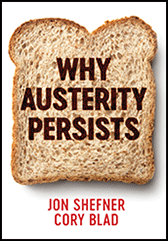
Austerity as the Hammer of Neoliberalism
Review of Why Austerity Persists by Jon Shefner and Cory Blad (Polity, 2020)
This article is from Dollars & Sense: Real World Economics, available at http://www.dollarsandsense.org

This article is from the
May/June 2021 issue.
Subscribe Now
at a 30% discount.
Earlier this year, in the midst of the country’s recovery from the Covid-19 pandemic, Bolivia’s Central Bank made an unprecedented move: Instead of continuing to be saddled with a loan of over $350 million from the International Monetary Fund (IMF), they decided to return the loan, with interest, to the IMF. In a public statement, the bank described the terms of the loan as being “irregular and onerous due to financial conditions.”
While this incident didn’t receive much coverage in the mainstream press, it highlights the impact and prevalence of the austerity policies that the IMF and similar institutions attach as conditions to the loans they provide to countries across the globe. But how did we get here? And why is austerity so pervasive? In Why Austerity Persists, Jon Shefner and Corby Blad grapple with these questions by delving into the 45-year history of this economic policy that has been promoted by mainstream economists and which governments have adopted, despite overwhelming evidence of austerity’s failure to increase growth and improve living standards.
Of course, the IMF isn’t the only institution making loans with these kinds of conditions. Along with the IMF, the World Bank, the European Central Bank, and similar international institutions all claim that austerity resolves a myriad of economic obstacles. These institutions have promoted austerity as “the medicine to cure all ills” for such diverse problems as structural obstacles to industrializing the Global South, currency crises, and the collapse of a real-estate bubble in the Global North, making it a global “go-to policy.” However, by tracing the roots of these policies back to the rise of neoliberalism in the 1970s, Shefner and Blad show that the “medicine” of austerity actually serves as a cudgel to discipline and control countries across the world.
Since the 1970s, the aim of the neoliberal project in the Global South has been to use austerity as a hammer to destroy the region’s developmental capacity, discipline and control its labor force, and make their economies dependent on international capital. In the Global North, austerity, starting with the Reagan and Thatcher governments of the early 1980s, has slowly hammered away at worker protections, guaranteed pensions, access to health care, and access to well-funded public education. Despite the anti-state rhetoric of neoliberalism, its aim has not been to reduce the size of the state but to reduce state social services and public goods as much as possible by using austerity to privatize the costs of these services and goods, while socializing the costs of the increased public debt that governments have accumulated by providing bailouts and tax breaks to private financial institutions and multinational industries, and requiring those in the working class and middle class to foot the bill by paying higher taxes.
In turn, when the state is mired in public debt from borrowing instead of taxing, the resulting debt crisis is used to control and limit state activity to protect labor and reduce its welfare services while making way for finance and international capital speculations. In this way public debt is increasingly used as a tool to control and discipline the state and prevent it from being used for broader social goods. As Shefner and Blad demonstrate in their case studies (more on these below), the three groups that advocate for and implement these neoliberal austerity programs are the global elite, who either cajole or strong-arm national elites into implementing austerity measures; the national elites themselves; and the international financial institutions, which the national elites enable. Together, these three groups are the intellectual advocates as well as the administrators of austerity. When austerity policies have not worked, instead of allowing for alternatives, the members of these groups argue that there should be an increased dose of austerity to shock an economy out of its anemic condition. This is the irony of austerity’s persistence.
While Latin America was the laboratory where most of these austerity policies were first implemented in the 1970s and 1980s, its poor results did not stand in the way of its application throughout the world. The authors explain in detail how deeply ingrained neoliberal ideas, such as austerity, are in the policy world by using 11 case studies from five continents, which include three countries in Latin American (Chile, Mexico, and Ecuador); two in Africa (South Africa and Zimbabwe); three in Asia and Oceania (Thailand, Indonesia, and New Zealand); three in Europe (Greece, Spain, and Britain); and in North America, the United States. Through hook or by crook, neoliberalism has influenced the economic policies adopted in a myriad of political systems, whether they were authoritarian or dictatorial regimes or Western liberal democracies. In all 11 cases, inequality, poverty, general and youth unemployment, and real estate prices increased while wages stagnated and/or declined and overall national economic growth rates were lower than in the years of state-led development between the 1950s and the early 1970s. Austerity has increased misery and hardship for the average person (at least the bottom 80% of the population) while it has strengthened the power of corporations and elites.
Let’s take two examples from the book to understand the true cost of these “go-to policies.” First, there is the classic example of Chile, which had been a maturing democratic country from the early 20th century until the bloody military coup on September 11, 1973 (aided and abetted by the CIA) that removed the elected president Salvador Allende and replaced him with the U.S.-backed dictator General Augusto Pinochet. The military junta immediately went to work implementing neoliberal policies which were written and planned by the “Chicago Boys” (mainly the sons of Chile’s elite who were educated at the University of Chicago and influenced by Milton Friedman). The so-called “shock treatment” of austerity was aimed at reversing decades of hard-fought industrial and agricultural worker rights, eliminating price controls, privatizing banks and public companies, selling off the government pension system and part of the national health service, reducing spending on health care and education, and laying off one-third of government employees, while increasing spending on the military and the police. As a result, by 1982 per capita GDP had declined by 14%, yet the wealth of Chile’s elite had increased substantially. Despite increasing poverty and job insecurity and the resulting economic crisis, Chile was used as a model for many other Latin American countries to follow.
Whereas Chile’s austerity policies had been implemented by first transferring the country into a dictatorship where as many as 10,000 people were killed and several thousands more were disappeared and tortured, the example of the United States shows us that you can also implement neoliberal policies in more formally mature liberal democracies, albeit more slowly and without much overt government oppression. When U.S. industrialists started experiencing international competition and declining profits in the 1970s, they decided to outsource manufacturing jobs in order to lower labor costs, and disinvested in manufacturing in the United States. This led to the loss of between 32 and 38 million manufacturing jobs by the end of the 1970s, essentially deindustrializing the U.S. economy. These job losses also spurred a rapid decline in unionization: union membership declined from about 30% of U.S. workers in the 1950s to about 13% by 2011. The decline of the unions weakened labor’s leverage to resist capital’s squeeze on workers by increasing work hours, reducing real wages, and cutting health and pension benefits. Further-more, the closing of thousands of factories led to smaller local tax bases. These political and economic developments paved the way for austerity policies to seem like the most logical tool available for politicians who then lowered taxes on corporate profits and the wealthy, increased financial incentives for business to encourage them to stay at the expense of cutting local public services, and deregulated the economy. The result, according to the authors, of 45 years of austerity has led to “savage results in the United States” by increasing the poverty rate, shrinking the middle class, increasing income and wealth inequality, and reducing welfare benefits.
Millions of people, however, have also protested, resisted, and organized against austerity. Major social movements like the pink tide in Latin America and the formation of new political parties (like Syriza in Greece or Podemos in Spain) have pushed back against austerity policies. But as the book documents, so far these movements have not prevailed. More times than not, the people resisting austerity have been disappointed by the political parties on the left or right who run on anti-austerity campaigns but then succumb to the pressures of the global international forces and their own national elites to implement austerity policies once elected. That is why austerity has persisted despite attempts to resist it.
Nevertheless, Shefner and Blad maintain that while austerity has persisted, it is not inevitable. There are genuine progressive alternatives that anti-austerity social movements could fight for to push their countries toward greater national sovereignty for formulating economic policies. National sovereignty would allow a country to formulate economic policies—such as regulating the financial industry or limiting the privatization of national companies—that are good for their own economic development and growth without being constrained by international agreements with the IMF or World Bank. However, these changes can only happen if these movements are able to sweep away the international elite’s power to impose pressure on their national elites to implement austerity policies, which have thus far persisted.
Did you find this article useful? Please consider supporting our work by donating or subscribing.
